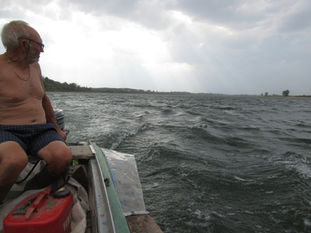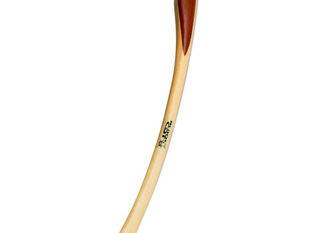
Of the three families along the bank, the nearest is the one my father calls Topolite. As described in the previous blog, the family’s home base is at Km 728 - only a kilometre upriver from my father’s camp. During the summer, the core foraging territory of the family stretches along the bank all the way up to the Topolite campsite at Km 732. In July-August many camps spring up between 728 and 732, but the last one is the biggest. This turns it into a focal resource for the family, giving their name.
It was mentioned before, that one way to establish who is who on the bank is by listening to howling matches between neighbouring jackal families. Apart from such long-distance monitoring – usually done from a boat during night fishing – behaviour immediately at the bait-site is informative. A crucial feature is the point of entry into the bait-site, as well as the manner that is done.
Below, this is illustrated by showing the most common trespassers at Boldy’s family bait-site. A junior adult jackal with an exceedingly long muzzle is one of them. He comes from Km 728 – the ‘home’ of the Topolite family. My father calls him Long Nose:
Apart from his look, a detail which reveals him as a trespasser from Topolite is his point of entry. Long Nose always enters from the left of the stage after crossing the square in front of my father’s tent. Then he takes the path my father uses when going to the bait-site. It is not the path anyone from Boldy’s family would habitually take. Boldy’s people usually enter from the path coming down from their ‘home’, i.e., down the Eastern staircase. Another favourite route is by the home-to-river path. Boldy’s people would use it to go to the river for a drink of water and on the way back stop for a bite at the bait-site. First drink and then eat. From there on – roam the fields.
Then there is the almost vertical path down the bluff. Senior adults – particularly Big Man or White Back – would at times prefer it when coming from the fields above. Big Man directly jumps onstage. White Back prefers to make a circle behind my father’s tent, then goes all the way down to the river, and from there takes the river path up to the stage. It is thus the case that for anyone from Boldy’s family to come onstage from the left (western) side of the bait-site – as we look down towards the river - is not a normal choice. Consequently, for someone to come along my father’s path is a sure sign of being a stranger. Here is the place to say that the choice of a particular route is always individual and amounts to a personal signature. Such is also the manner of walking up to a resource – in our case, the bait-site.
It is thus that besides the choice of a path leading up to the bait-site, the manner of entering it individualizes a jackal. In this case, whether they are hosts, or are trespassers from other families. In Fig. 1, Long Nose is very tense and visibly afraid. Hosts, by contrast, enter in a generally more confident manner.
The nervousness of Long Nose makes him perform an act of ‘twigging’ as soon as he crawls out into the open. He snaps a morpha twig between his teeth, and breaks it. A crashing noise is produced. This might be intended to provoke a lurking host to make a movement and reveal themselves. Alternatively, it may be done out of sheer nervousness. In any case, Long Nose then crawls up carefully towards the bowl. While crawling, he swings his head and upper body from side to side. This is the ‘pendulum’ gait and head movement. It is a sign of heightened nervousness in the manner of a boxer jumping from side to side dodging a punch. Eventually, Long Nose begins sniffing at the bowl to see what it is about. He then seems to hear some noise from the top of the bluff and jumps backwards into the bush as if pulled by a rubber band. He fixes his gaze on the bluff, freezing for about ten seconds. Then his gaze moves lower to look at the cameras – he is not at ease with them, unlike the hosts who see them every night. In the end, Long Nose decides against taking anything at all and pulls back under cover, his eyes darting about. A tense and wary trespasser, to be sure.
Not all trespassers are like that. There is a big lean male who does not seem to be greatly frightened by the hosts. His body looks striped and my father calls him The Hyena.
This character chooses the same point of entry as the timid Long Nose: my father’s path from square to bait-site. As different from Long Nose however, he dispenses with precautions like crawling, ‘twigging’, and ‘pendulum’ swinging. Instead, he walks with a sure step up to the bowl and starts eating. Moreover, he is invariably accompanied by a young female whom my father calls The Girlfriend. She keeps closer to the wings of the stage, often lifting her head and peering into the bushes and up the bluff trying to discover lurking hosts.
The Hyena’s self-assurance is such that at times he can be seen with his back to the cameras: the ultimate sign of confidence:

A reason for such confidence may be seen in the time of the visit: 4:40 in the morning. According to established bait-site order, the hosts have finished eating before midnight and are now roaming the outer family territory. If we look at the map in the previous blog, they may be scattered along the bank and over the fields as far as the asphalt road from Stanevo to Kovachitsa.
Sometimes the tactic does not work. This happens particularly when White Back assumes his role as a bait-site custodian and a supervisor of the young. As said before, this is in the post-denning period from about mid-July on.
When White Back surprises a trespasser, a violent quarrel erupts. True to the jackals’ code of conduct in such situations, the scandal does not escalate into blood-letting fights. In a recording from 20 July last year, the scandal began with a cackling exchange between White Back and an unseen trespasser:
As seen in the clip, the stand-off was played out by the old poplar tree, possibly at the moment a trespasser was trying to reach the bowl. Knowing the date (20 July, i.e., past denning-time), it was quite in order that White Back would be the one to defend the interests of the family. As he jumped into the bushes after the opening cackling, we can see that it was indeed him.
After the initial scuffle with the intruder, White Back retreated into the wings and to the right of the picture – towards the river path. At the other end, the trespasser was crouching under the twigs by the roots of the old poplar tree. In the end, he found it more prudent to retreat along my father’s path. His eyes were seen when crossing the square and heading westwards. With that the incident was over.
The established way to avoid such embarrassing situations was to stick to proper timing. As described in the case of the Hyena earlier on, early morning is the time trespassers may use. This is not by way of invitation at all, but so to say, by default. Meaning that by that time the hosts would be roaming far and wide in search of additional opportunities – to top up the often meagre offerings at the bait-site.
In this arrangement, the period decidedly off-limits for trespassers, was the prime-time slot: from 18:30 – 19:00 hrs. until about half-ten or, at the most, midnight. During denning time (mid-May – mid-July), the daylight part of the prime slot – 18:30-21:00 - would be reserved for the Mother. In all events, trespassers’ appearance at the bait-site before 3-4 in the morning is considered very bad manners. The stand-off scene in Fig. 4 happened at 01:48 – clearly not late enough for trespassers to appear at the bait-site.
But, on the whole, such things rarely happen. It could be that various signals with a ‘stay away’ meaning, work. In the first place, this is by urine- or faeces-marking of the bait-site, and the paths leading up to it. ‘Chemical marking’, as the zoologists call it, is an important way of relating messages. It denotes not only the presence of a particular animal, but also the time they had been around.
In addition, the dominant male, Big Man, uses another device to send fear all around: earth-throwing. Sensing trespasser’s presence in the vicinity of the bait-site at prime-time, he urine-marks the stage and, in addition, does the hind-legs-earth-throwing act:
Two things need to be noted here. In the first place, the urine-marking posture is characteristically male: the left hind leg is raised high like dogs do at a post. This is helpful in the process of individuation – a notoriously difficult task with jackals. They are characterized by a low degree of sexual dimorphism, meaning that male and female animals look similar. Establishing who is male, and who is female, helps to avoid thinking of two different animals as being one and the same.
An additional thing about Big Man’s urine-marking posture is that his tail is horizontal, and that he is looking towards the square. The horizontal position of the tail denotes excitement, while his looking towards the square - the direction from which trespassers from the Topolite group usually come – means that a trespasser may be already there. The earth-throwing act seems to be effective as no intruder appears thereafter.
An exception to trespasser-chasing seems to be made in the case of breast-feeding mothers from neighbouring families. A case in point is the appearance of such a neighbour very close to the end of the prime-time slot.
On 12 July, 2024, a female from a neighbouring family appeared at the bait-site. The time was 00:31 which is very shortly after the usual midnight end of the prime-time slot. The female’s nipples suggested still breastfeeding a litter of possibly four pups:

This is an important observation which suggests that mothers are breastfeeding for a period of about two months. Another thing to notice is that the female is staring at the cameras with her tail between her legs. This is a sign that - as a stranger - she is not at ease with the cameras, apart from the trespassing act making her understandably tense. She crawls up to the bowl, snatches a piece and jumps back in the wings on the right to eat it.
Judging by the black ‘socks’ on her legs, she has been to the river first, wading in the mud along the river-edge. The surprising thing is that she stays at the bait-site for over eight minutes: 00:30:40 – 00:39:56. This is a long time for a jackal’s visit, and moreover a trespassing visit. Usually, a visit to one’s own focal resource is between three and five minutes long. There is a suggestion in this case, that she somehow feels that there will not be any chasing her away, possibly because she is still nursing her pups. The hosts must have decided to clear out from the place leaving the nursing mother to eat in peace. They have had their share – let there be something for others who are in need.
This noble act may emphasise the support nursing mothers receive not only by their own family but by neighbouring families too.







